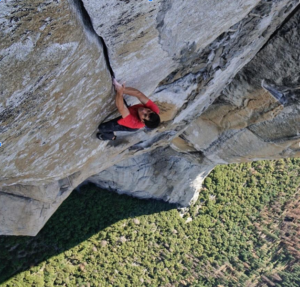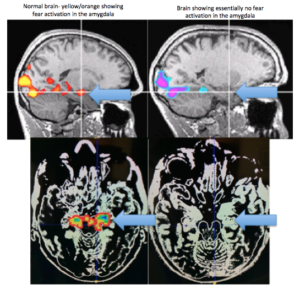
Image taken from “Free Solo”
While I rarely follow the Oscars, I was made aware of the 2019 Best Documentary Feature winner, “Free Solo”. Intrigued by the story, I watched this movie with my family. When observing this young man plan and climb El Capitan in Yosemite, by himself and without any ropes or protective equipment, I found all of us repeating, “That guy must be crazy”.
Mid-way through the movie, sentiment is addressed by showing the functional MRI results of the main character.
A functional MRI (fMRI) is a special type of MRI in which the person is asked to perform tasks, or in this instance look a pictures, while the MRI is being performed. In this example, the main character was shown “arousing” or “scary” pictures and the brain activity was recorded. In a “normal” person, the portion of the temporal lobe, called the amygdala, activates in response to fear. In the main character, the amygdala did not seem to activate.
Emotions are a complex phenomena that involves multiple areas of the brain. It is not fully elucidated, but the typical belief is that “emotions” involve the “limbic system”. This includes the temporal lobe and portions of the frontal lobe. However fear, specifically, seems to originate in the amygdala. This comes from the work of Kluver and Bucy in Chicago in the early 1900’s who noted that after bilateral resection of the amygdala, monkey’s did not display anger or aggression and did not fear humans.

Fear is an extremely important emotion for any animal’s safety. In a “fight or flight” response, quick recognition of fear allows us to evaluate the scenario and appropriately react. This also has a memory component so that we remember dangerous situations and do not need to repeatedly react to the same scenario as if it was new.
In the movie, “Free Solo”, we get a glimpse of two effects from a suppressed amygdala in a unique way. First, the main character pursues extreme thrill seeking behaviors like rock climbing without a rope. This is a unique representation of a thrill seeking personality, in that he has control. He pursues rigorous training, he exhibits restraint (he abandoned his first attempt when it did not feel right), and he adheres to his pre-planned blueprint when he finally makes the attempt. Many thrill-seekers succumb to lack of control and impulsivity with drug seeking, gambling or dangerous sexual behavior. The second component is that the main character also seemingly exhibits some memory dysfunction. In two scenarios during this documentary, he falls during training, injures himself, but claims he does not remember the falls. The limbic brain circuit, which includes the amygdala, is intimately involved in long-term consolidation and retrieval of memory. However, the main character also maintains a terrific photographic memory of the ~3,000 foot route he traversed over 3 hours and 56 minutes. The lateral temporal lobe (likely normal in the main character) is thought to control “working memory”.
From the neurosurgical perspective, our understanding of the amygdala and memory function in the temporal lobe impacts how we operate around these brain structures. We unfortunately discover the function of specific brain areas when they are damaged or malfunction. The main character of this movie give great insight into the amygdala, temporal and frontal lobes.






